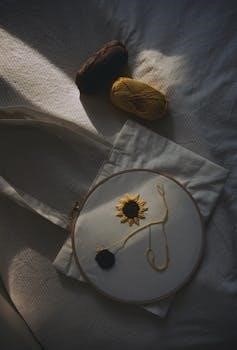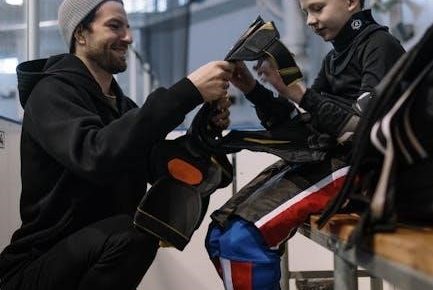Cross stitch is a wonderfully simple and relaxing hobby! This guide is filled with instructions on how to cross stitch, including extra resources․ Learn about essential materials and how to start stitching․ This is a perfect guide for beginners!
Cross stitch is an accessible and enjoyable needlework technique, perfect for both beginners and experienced crafters․ It involves creating X-shaped stitches on fabric with a uniform weave, typically Aida cloth․ These stitches come together to form a design, following a pattern or chart․
The beauty of cross stitch lies in its simplicity․ The basic stitch is easy to master, and projects can range from small, quick patterns to large, intricate scenes․ It’s a fantastic way to relax, be creative, and produce personalized artwork․
Whether you’re looking to create unique gifts, decorate your home, or simply unwind, cross stitch offers endless possibilities․ This introduction will guide you through the fundamentals, helping you understand the basics and prepare for your first project․ With a little practice, you’ll be stitching beautiful designs in no time․
So, grab your supplies, find a comfortable spot, and get ready to explore the world of cross stitch!

Essential Materials for Beginners
To embark on your cross-stitch journey, you’ll need a few essential materials․ First, choose Aida cloth, the most popular fabric due to its evenly spaced holes․ A 14-count Aida is recommended for beginners․ Next, gather embroidery floss, preferably DMC, and select colors according to your chosen pattern․
You’ll also need a tapestry needle with a blunt tip and a large eye to easily accommodate the floss․ A pair of small scissors is essential for trimming threads․ While optional, a hoop or frame can help keep your fabric taut and prevent distortion․
Consider purchasing a cross-stitch pattern or kit designed for beginners․ These kits often include all the necessary materials and instructions․ If you’re creating your own design, a cross-stitch chart will be invaluable․
Finally, good lighting and a comfortable workspace are crucial for a pleasant stitching experience․ With these materials in hand, you’ll be well-equipped to start your first cross-stitch project! Remember to sign up for newsletters that have free planning sheets and patterns․
Reading a Cross Stitch Pattern or Chart
A cross-stitch pattern is your roadmap to creating a beautiful design․ It typically consists of a gridded chart representing the fabric, with symbols indicating where to stitch and which color to use․ Each square on the chart corresponds to a stitch on the Aida cloth․
Accompanying the chart is a color key or legend․ This key lists each symbol used in the pattern, along with the corresponding color code, name, and brand of embroidery floss (DMC being a popular choice)․ The key also specifies the number of strands to use for each color․
To read the chart, locate the center point, often marked with arrows․ Starting from the center, follow the symbols to determine where to place each stitch․ Count the squares carefully to ensure accurate placement․ Pay close attention to the color key to select the correct floss․
Some patterns may include backstitch details, indicated by lines on the chart․ These are typically added after the cross-stitches to define outlines and add finer details to the design․
With practice, reading cross-stitch patterns becomes second nature, unlocking a world of creative possibilities!
Preparing Your Fabric (Aida Cloth)
Aida cloth, the most popular fabric for cross stitch, requires some preparation before you begin stitching․ Start by ironing your Aida cloth to remove any wrinkles․ This will ensure a smooth surface for stitching and prevent distortion of the design․
Next, consider securing the edges of the fabric to prevent fraying․ Fraying can make it difficult to stitch near the edges and can gradually reduce the size of your fabric․ You can use masking tape to enclose the edges, preventing unraveling․ Alternatively, you can sew a zigzag stitch along all the edges for a more permanent solution․
If you plan to use a hoop, center the Aida cloth within the hoop, ensuring it is taut and evenly stretched․ This will provide a stable surface for stitching and help maintain consistent stitch tension․
For your first project, a square of Aida cloth at least 5×5 inches is recommended․ This size provides ample space to practice and prevents feeling cramped․

With your Aida cloth prepped and ready, you’re one step closer to embarking on your cross-stitch adventure!
Finding the Center of Your Fabric

Locating the center of your Aida cloth is a crucial initial step in cross-stitch․ Starting from the center ensures your design is evenly placed and prevents running out of space as you stitch outwards․ To find the center, fold your Aida cloth in half lengthwise, pressing lightly to create a crease․ Unfold it, then fold it in half widthwise, again pressing to create a crease․
The intersection of these two creases marks the precise center of your fabric․ To clearly mark this point, you can use a water-soluble pen or a basting stitch in a contrasting color․ These methods will help you easily identify the center as you work on your project․
Alternatively, you can measure the height and width of your Aida cloth and divide each measurement by two․ Use a ruler to mark the midpoint of each side, then draw lines connecting these midpoints to find the center․
By accurately finding and marking the center of your fabric, you set the foundation for a well-proportioned and visually appealing cross-stitch design․ Remember, starting in the center ensures your pattern remains balanced within your chosen fabric dimensions․
Threading the Needle and Knotting the Thread
After preparing your fabric, the next step is threading your needle and knotting the thread․ Cut a piece of embroidery floss about 20 inches long to prevent tangling․ Separate the floss into strands; beginners usually use two or three strands for 14-count Aida cloth․
To thread the needle, moisten the end of the floss and carefully push it through the eye of the needle․ Pull a few inches of thread through the eye to secure it․
Next, knot one end of the thread․ There are several methods, but a simple overhand knot works well for beginners․ Wrap the end of the thread around your finger, then roll it off, creating a loop․ Pull the end of the thread through the loop and tighten the knot close to the end․
Some advanced stitchers prefer waste knots or burying the thread to avoid bumps, but a standard knot is sufficient for starting․ Ensure the knot is secure to prevent it from pulling through the fabric as you stitch․
With your needle threaded and knotted, you’re ready to begin the first leg of your cross-stitch, setting the stage for creating beautiful designs on your Aida cloth․
Starting the Stitch⁚ The First Leg
With your needle threaded and knotted, you’re ready to start the first leg of your cross stitch․ Begin by choosing a hole in the middle of your Aida cloth to ensure your pattern stays centered․ Push the needle up through the back of the fabric and pull the thread until the knot gently touches the back․
Next, insert the needle into the hole diagonally across from where you started, usually down and to the right․ Pull the thread through, creating the first diagonal stitch․ Ensure the thread is taut but not too tight; you want it snug against the fabric without puckering it․
This diagonal stitch forms the first leg of your cross․ It’s crucial to maintain consistent tension to create uniform stitches․ As you become more comfortable, you can experiment with different techniques, but for now, focus on making each stitch neat and even․
Completing the first leg is a significant step․ You are now halfway to completing your first cross stitch․
Keep the tension consistent and always start in the middle of your fabric․

Completing the Cross Stitch⁚ The Second Leg
Now that you’ve completed the first leg of your cross stitch, it’s time to finish the cross by adding the second leg․ Bring your needle up through the hole diagonally opposite from where you ended the first leg․ This means if your first stitch ended in the bottom right, you’ll bring the needle up through the top left․
Next, insert the needle into the remaining empty hole, which should be diagonally across from where you just came up․ Pull the thread through to complete the “X” shape․ Ensure your thread tension remains consistent to maintain a uniform look․ The goal is to create a balanced and neat cross stitch․
Make sure that the part of the X looks even․ Sometimes it won’t make sense to do that, so it’s not a hard rule․ Just make sure that each stitch looks neat․
Congratulations, you’ve completed your first cross stitch! By following these steps, you can create beautiful and intricate designs․ Keep practicing to refine your technique and explore different patterns․
Securing the Thread at the End
Once you’ve completed a section or run out of thread, it’s essential to secure the thread at the back of your work to prevent it from unraveling․ Turn your fabric over so that the back is facing you․
Carefully weave the needle under several stitches on the back, running it along the same color threads to hide the tail․ Avoid weaving through contrasting colors to keep the back neat․ Gently pull the thread through, ensuring not to pull too tightly, which can distort the fabric․
Trim the excess thread close to the fabric, leaving a small tail that is tucked securely under the stitches․ This ensures that the end is neat and hidden․
Avoid tying knots, as they can create bulk and be visible from the front․ By using this method, you’ll maintain a clean and professional finish to your cross-stitch project․ This technique keeps your work secure and prevents the thread from coming undone․
Tips and Tricks for Beginners
Starting with a Kit⁚ Begin with a simple cross-stitch kit to familiarize yourself with the materials and techniques․ Kits usually include fabric, thread, needles, and a pattern, providing everything you need to get started․
Lighting is Key⁚ Ensure you have good lighting to see the fabric and thread clearly․ A well-lit workspace reduces eye strain and helps you avoid mistakes․
Use a Needle Threader⁚ A needle threader can make threading the needle much easier, especially for beginners․ This small tool saves time and reduces frustration․
Practice Makes Perfect⁚ Don’t be discouraged if your first few stitches aren’t perfect․ Cross-stitch is a skill that improves with practice, so keep stitching to enhance your technique․
Keep Tension Consistent⁚ Maintain consistent tension on your thread to ensure that your stitches are even and neat․ Avoid pulling the thread too tightly, which can distort the fabric․
Count Carefully⁚ Always double-check your stitch placement by counting the squares on your fabric․ Accurate counting is essential for following the pattern correctly and achieving the desired design․


